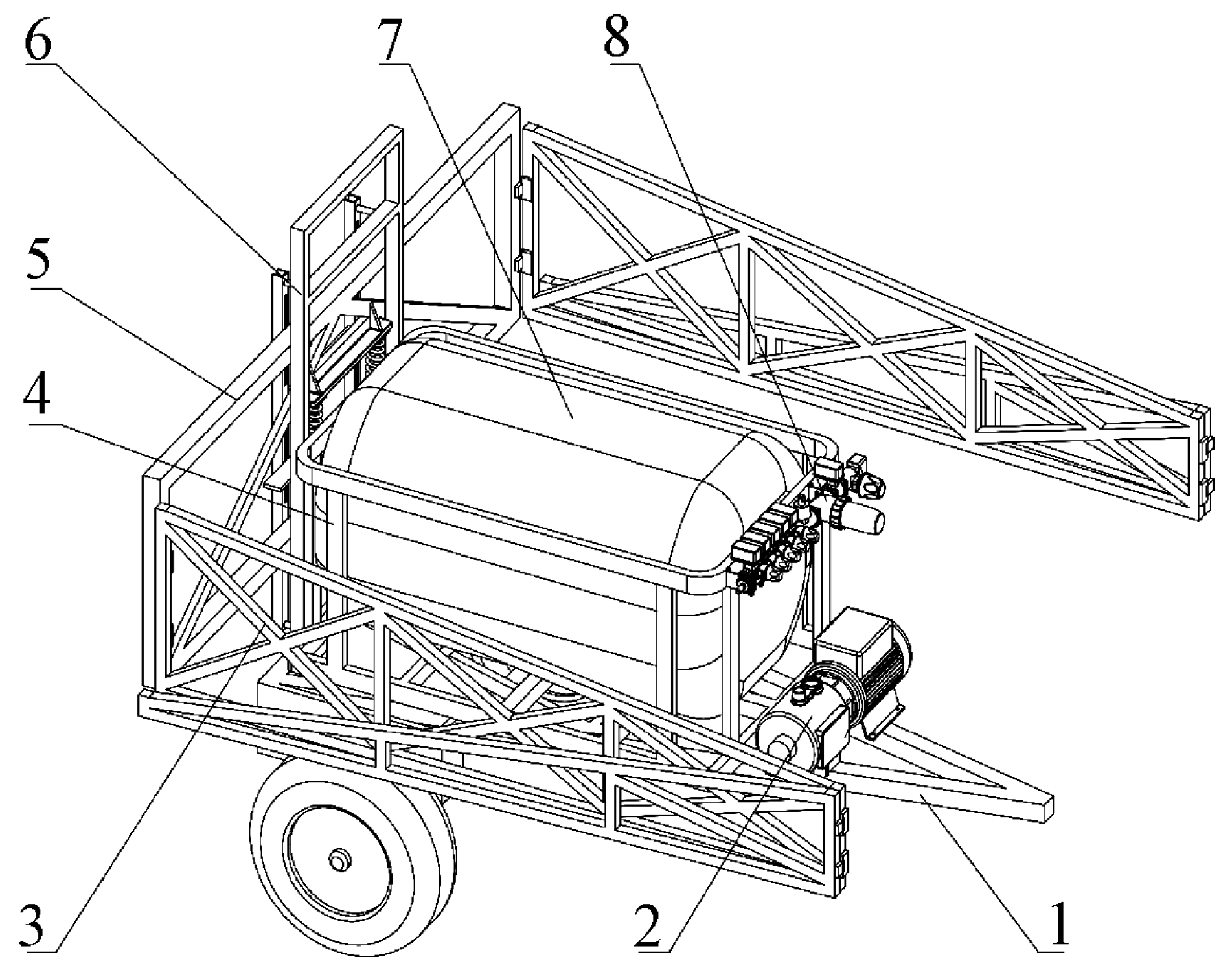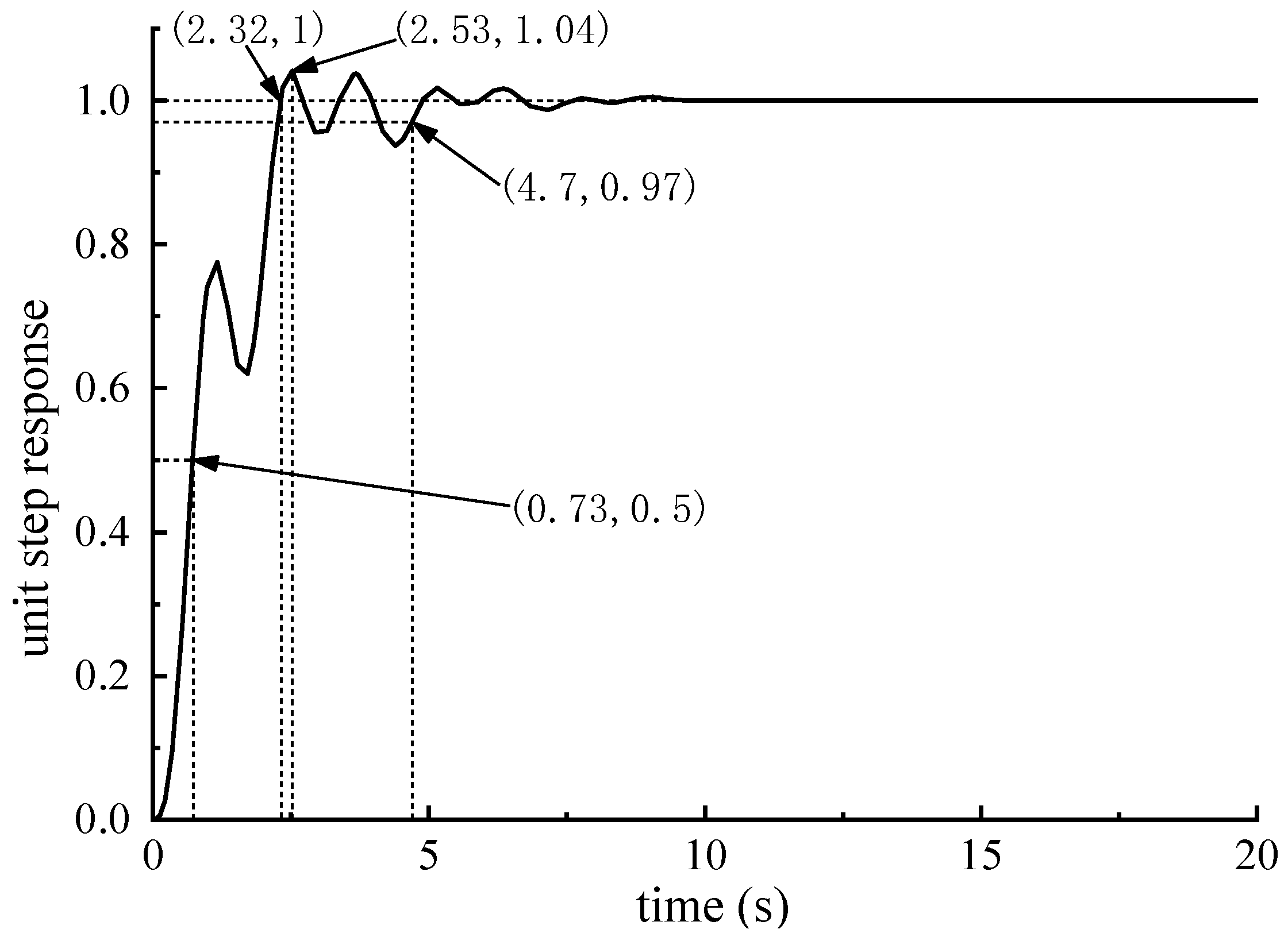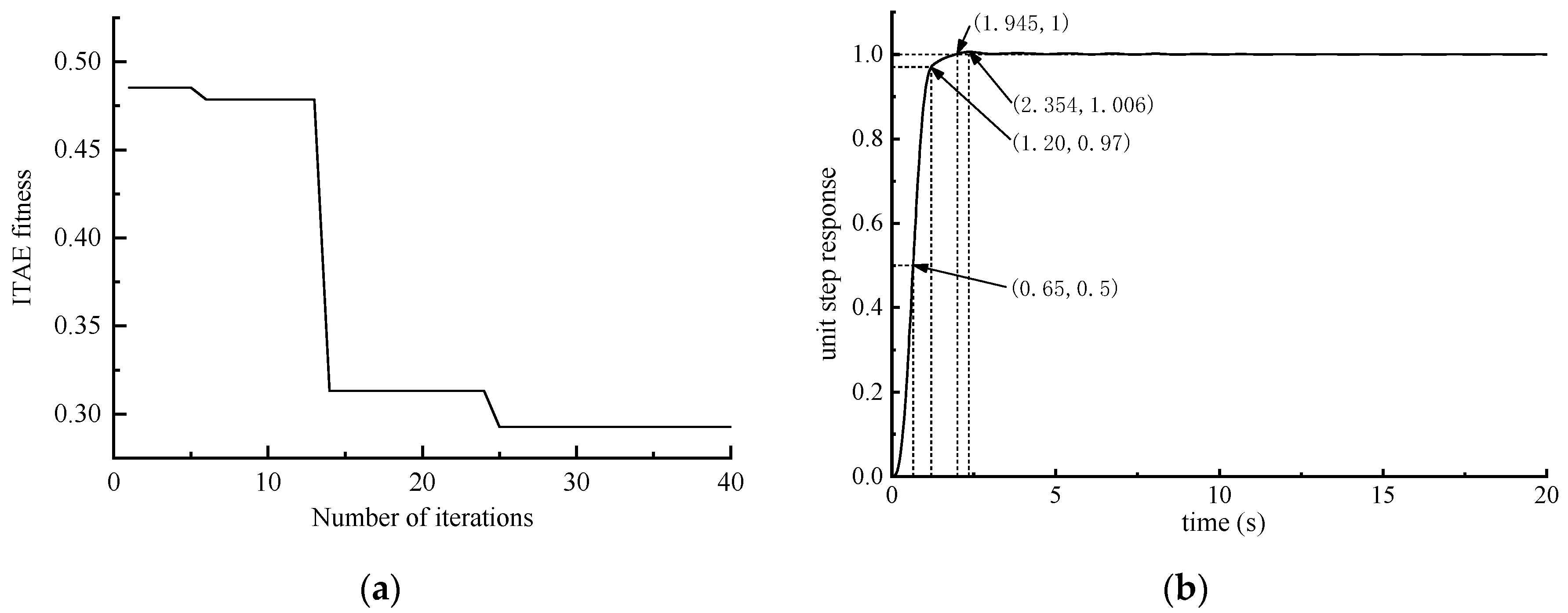Control System of Liquid Fertilizer Variable-Rate Fertilization Based on Beetle Antennae Search Algorithm
Abstract
:1. Introduction
2. Structure and Working Principle of Fertilizer Applicator
3. Liquid Fertilizer Variable-Rate Fertilization Control System Modeling
4. Simulation Analysis of Control System Model
4.1. Beetle Antennae Search Algorithm
4.2. Beetle Antennae Search Algorithm to Optimize PID Parameters
4.3. Simulation Analysis of Control System
4.3.1. Simulation of PID Control System
4.3.2. Simulation of Fuzzy PID Control System
4.3.3. Simulation of PID Control System Based on Beetle Antennae Search Algorithm
5. Bench Test
5.1. Experimental Materials and Platform
5.2. Results and Analysis
5.2.1. Stability Experiment of Control System
5.2.2. Variable Control Experiment
6. Discussion
- (1)
- This study uses the beetle antennae search algorithm combined with the PID control algorithm to optimize the system. The model of liquid fertilizer variable-rate fertilization control system was established. The adaptive optimization of PID parameters by using a beetle antennae search algorithm can effectively improve the performance of system transient response.
- (2)
- In this study, the negative feedback regulation process of the liquid fertilizer variable-rate fertilization control system was analyzed, and the control system was modeled and simulated by computer software. The results show that the response time of the traditional PID control to achieve steady-state is 2.5 s, and the overshoot is 0.014. The response time of PID control based on the beetle antennae search algorithm is 1.2 s and the overshoot is 0.006. Compared with the traditional PID control, the response time of the optimized system is reduced by 1.3 s, and the overshoot is reduced by 0.008.
- (3)
- The bench test results show that for the variable-rate fertilization control system in this paper, the relative error of flow rate of the traditional PID control is 4.39%, and the relative error of flow rate of the PID control based beetle antennae search algorithm is 1.27%. The actual response time of PID control based on the beetle antennae search algorithm is 2 s. Therefore, the actual control effect of PID control based on the beetle antennae search algorithm is better. The results can provide a feasible scheme for foliar fertilization or spraying control in cotton fields.
7. Conclusions
Author Contributions
Funding
Institutional Review Board Statement
Informed Consent Statement
Data Availability Statement
Acknowledgments
Conflicts of Interest
References
- Zhenhua, X.; Caijuan, G.; Wenqi, M.; Jing, W. Study on the relationship among yield, nutrient efficiency and benefits of grain crop in typical regional areas of China. Chin. Agric. Sci. Bull. 2011, 27, 116–122. [Google Scholar]
- Shi, Y.; Zhu, Y.; Wang, X.; Sun, X.; Ding, Y.; Cao, W.; Hu, Z. Progress and development on biological information of crop phenotype research applied to real-time variable-rate fertilization. Plant Methods 2020, 16, 1–15. [Google Scholar] [CrossRef] [PubMed]
- Guifen, C.; Li, M.; Hang, C. Research status and development trend of precision fertilization technology. J. Jilin Agric. Univ. 2013, 35, 253–259. [Google Scholar] [CrossRef]
- Wang, G.; Hao, Y.; Chen, Y. Research on the model of variable-rate fertilization in Maize Based on Geographic Information System. In Proceedings of the 2015 6th International Conference on Manufacturing Science and Engineering, Guangzhou, China, 28–29 November 2015; Atlantis Press: Dordrecht, The Netherlands, 2015. [Google Scholar] [CrossRef]
- Yang, C.; Everitt, J.H.; Bradford, J.M. Comparisons of uniform and variable rate nitrogen and phosphorus fertilizer applications for grain sorghum. Trans. ASAE 2001, 44, 201–210. [Google Scholar] [CrossRef]
- McBratney, A.; Whelan, B.; Ancev, T.; Bouma, J. Future directions of precision agriculture. Precis. Agric. 2005, 6, 7–23. [Google Scholar] [CrossRef]
- Yuan, J.; Liu, C.L.; Li, Y.M.; Zeng, Q.; Zha, X.F. Gaussian processes based bivariate control parameters optimization of variable-rate granular fertilizer applicator. Comput. Electron. Agric. 2010, 70, 33–41. [Google Scholar] [CrossRef]
- Ruicheng, D.; Bingcai, G.; Ningning, L.; Chenchen, W.; Zidong, Y.; Mingjian, M. Design and experiment on intelligent fuzzy monitoring system for corn planters. Int. J. Agric. Biol. Eng. 2013, 6, 11–18. [Google Scholar]
- Koch, B.; Khosla, R.; Frasier, W.M.; Westfall, D.G.; Inman, D. Economic feasibility of variable-rate nitrogen application utilizing site-specific management zones. Agron. J. 2004, 96, 1572–1580. [Google Scholar] [CrossRef] [Green Version]
- Huang, Y.; Thomson, S.J.; Hoffmann, W.C.; Lan, Y.; Fritz, B.K. Development and prospect of unmanned aerial vehicle technologies for agricultural production management. Int. J. Agric. Biol. Eng. 2013, 6, 1–10. [Google Scholar] [CrossRef]
- Nawar, S.; Corstanje, R.; Halcro, G.; Mulla, D.; Mouazen, A.M. Delineation of soil management zones for variable-rate fertilization: A review. Adv. Agron. 2017, 143, 175–245. [Google Scholar] [CrossRef]
- Yu, H.; Ding, Y.; Liu, H.; Zhu, W.; Liu, G.; Fu, X.; Ding, W. Optimization design and application of variable rate fertilization system for small-scaled fields. Trans. CSAE 2018, 34, 35–41. [Google Scholar] [CrossRef]
- Wensheng, Y.; Mei, J.; Chongyou, W.; Tiqiong, X. Development status and prospect of seed manure fertilizing mechanization in China. J. Agric. Mech. Res. 2011, 33, 1–5. [Google Scholar] [CrossRef]
- Ning, S.; Taosheng, X.; Liangtu, S.; Rujing, W.; Yuanyuan, W. Variable rate fertilization system with adjustable active feed-roll length. Int. J. Agric. Biol. Eng. 2015, 8, 19–26. [Google Scholar] [CrossRef]
- Yinyan, S.; Zhichao, H.; Xiaochan, W.; Odhiambo, M.O.; Weimin, D. Motion analysis and system response of fertilizer feed apparatus for paddy Variable-Rate fertilizer spreader. Comput. Electron. Agric. 2018, 153, 239–247. [Google Scholar] [CrossRef]
- Zhang, J.; Liu, G.; Luo, C.; Hu, H.; Huang, J. MOEA/D-DE based bivariate control sequence optimization of a variable-rate fertilizer applicator. Comput. Electron. Agric. 2019, 167, 105063. [Google Scholar] [CrossRef]
- Da Silva, M.J.; Magalhães, P.G. Modeling and design of an injection dosing system for site-specific management using liquid fertilizer. Precis. Agric. 2019, 20, 649–662. [Google Scholar] [CrossRef]
- Mendes, W.R.; Araújo, F.M.U.; Dutta, R.; Heeren, D.M. Fuzzy control system for variable rate irrigation using remote sensing. Expert Syst. Appl. 2019, 124, 13–24. [Google Scholar] [CrossRef]
- Reyes, J.F.; Esquivel, W.; Cifuentes, D.; Ortega, R. Field testing of an automatic control system for variable rate fertilizer application. Comput. Electron. Agric. 2015, 113, 260–265. [Google Scholar] [CrossRef]
- Zhang, J.; Hou, S.; Wang, R.; Ji, W.; Zheng, P.; Wei, S. Design of variable-rate liquid fertilization control system and its stability analysis. Int. J. Agric. Biol. Eng. 2018, 11, 109–114. [Google Scholar] [CrossRef]
- Qi, J.; Tian, X.; Li, Y.; Fan, X.; Yuan, H.; Zhao, J.; Jia, H. Design and experiment of a subsoiling variable rate fertilization machine. Int. J. Agric. Biol. Eng. 2020, 13, 118–124. [Google Scholar] [CrossRef]
- Xiuyun, X.; Xufeng, X.; Zelong, Z.; Bin, Z.; Shuran, S.; Zhen, L.; Tiansheng, H.; Huixian, H. Variable rate liquid fertilizer applicator for deep-fertilization in precision farming based on zigbee technology. IFAC-PapersOnLine 2019, 52, 43–50. [Google Scholar] [CrossRef]
- Jiang, Y.; Zhao, J.; Duan, J.; Hao, H.; Wang, M. Automatic control system of water and fertilizer based on fuzzy control algorithm and simulation. In Proceedings of the 2017 IEEE 2nd Information Technology, Networking, Electronic and Automation Control Conference (ITNEC), Chengdu, China, 15–17 December 2017; IEEE: Piscataway, NJ, USA, 2017; pp. 1671–1674. [Google Scholar] [CrossRef]
- Zhuang, T.F.; Yang, X.J.; Dong, X.; Zhang, T.; Yan, H.R.; Sun, X. Research status and development trend of large self-propelled sprayer booms. Trans. Chin. Soc. Agric. Mach. 2018, 49, 196–205. [Google Scholar] [CrossRef]
- Qian, Z.; Zhengying, W.; Yubin, Z.; Lei, Z.; Weibing, J.; Haoran, W. Rapid-response PID control technology based on generalized regression neural network for multi-user water distribution of irrigation system head. Trans. CSAE 2020, 36, 103–109. [Google Scholar] [CrossRef]
- Jicheng, Z.; Fanfeng, M.; Ping, Z.; Shouyin, H.; Wenyi, J. Variable rate control and fertilization system of liquid fertilizer applicator based on electronic control unit. Soybean Sci. 2019, 38, 111–117. [Google Scholar] [CrossRef]









| Parameters | Values |
|---|---|
| Overall dimensions (Folded state)/(m × m × m) | 2.16 × 2.20 × 1.78 |
| Height of frame base from ground/m | 0.526 |
| Fertilizer tank/(m × m × m) | 1.12 × 0.60 × 0.60 |
| Working width/m | 10 |
| Working height/m | 0.7~0.92 |
| Vehicle speed/(m·s−1) | 1~3 |
| Head range of pump/m | 5~50 |
| Parameter Name | Value |
|---|---|
| Amplification factor of the converter | 2 |
| Total armature resistance of the electric proportional valve | 2.68 Ω |
| Total armature inductance of the electric proportional valve | 3.87 mH |
| Motor torque coefficient of the electric proportional valve | 0.0429 N·m/A |
| Back EMF coefficient of the electric proportional valve | 0.042 V/(rad/s) |
| Rotational inertia of motor rotor of the electric proportional valve | 1.67 × 10−5 kg·m2 |
| Transmission rod guide | 0.005 m |
| Friction coefficient | 3.1 × 10−6 |
| Transmission ratio of the reducer | 100 |
| Proportional coefficient of flow and opening | 45 |
| Speed/ (m·s−1) | Theoretical Flow Rate/(L·min−1) | Traditional PID | PID Control Based on Taurus Search Algorithm | ||||
|---|---|---|---|---|---|---|---|
| Measured Flow Rate/ (L·min−1) | Absolute Error/ (L·min−1) | Relative Error/% | Measured Flow Rate/ (L·min−1) | Absolute Error/ (L·min−1) | Relative Error/% | ||
| 1.5 | 22.5 | 23.62 | 1.12 | 4.98 | 22.32 | −0.18 | −0.80 |
| 2.0 | 30.0 | 31.04 | 1.04 | 3.47 | 30.38 | 0.38 | 1.27 |
| 2.5 | 37.5 | 39.56 | 2.06 | 5.49 | 38.10 | 0.60 | 1.60 |
| 3.0 | 45.0 | 46.62 | 1.62 | 3.60 | 45.64 | 0.64 | 1.42 |
Publisher’s Note: MDPI stays neutral with regard to jurisdictional claims in published maps and institutional affiliations. |
© 2022 by the authors. Licensee MDPI, Basel, Switzerland. This article is an open access article distributed under the terms and conditions of the Creative Commons Attribution (CC BY) license (https://creativecommons.org/licenses/by/4.0/).
Share and Cite
Bai, J.; Tian, M.; Li, J. Control System of Liquid Fertilizer Variable-Rate Fertilization Based on Beetle Antennae Search Algorithm. Processes 2022, 10, 357. https://doi.org/10.3390/pr10020357
Bai J, Tian M, Li J. Control System of Liquid Fertilizer Variable-Rate Fertilization Based on Beetle Antennae Search Algorithm. Processes. 2022; 10(2):357. https://doi.org/10.3390/pr10020357
Chicago/Turabian StyleBai, Jinbin, Min Tian, and Jiangquan Li. 2022. "Control System of Liquid Fertilizer Variable-Rate Fertilization Based on Beetle Antennae Search Algorithm" Processes 10, no. 2: 357. https://doi.org/10.3390/pr10020357






